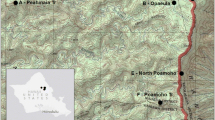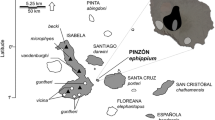Abstract
For conservation purposes islands are considered safe refuges for many species, particularly in regions where introduced predators form a major threat to the native fauna, but island populations are also known to possess low levels of genetic diversity. The New Zealand archipelago provides an ideal system to compare genetic diversity of large mainland populations where introduced predators are common, to that of smaller offshore islands, which serve as predator-free refuges. We assessed microsatellite variation in South Island robins (Petroica australis australis), and compared large mainland, small mainland, natural island and translocated island populations. Large mainland populations exhibited more polymorphic loci and higher number of alleles than small mainland and natural island populations. Genetic variation did not differ between natural and translocated island populations, even though one of the translocated populations was established with five individuals. Hatching failure was recorded in a subset of the populations and found to be significantly higher in translocated populations than in a large mainland population. Significant population differentiation was largely based on heterogeneity in allele frequencies (including fixation of alleles), as few unique alleles were observed. This study shows that large mainland populations retain higher levels of genetic diversity than natural and translocated island populations. It highlights the importance of protecting these mainland populations and using them as a source for new translocations. In the future, these populations may become extremely valuable for species conservation if existing island populations become adversely affected by low levels of genetic variation and do not persist.


Similar content being viewed by others
References
Amos W, Balmford A (2001) When does conservation genetics matter? Heredity 87:257–265
Amos W, Harwood J (1998) Factors affecting levels of genetic diversity in natural populations. Philos Trans R Soc Lond B Biol Sci 353:177–186
Ardern SL, Lambert DM, Rodrigo AG, Mclean IG (1997) The effects of population bottlenecks on multilocus DNA variation in robins. J Hered 88:179–186
Armstrong DP, Ewen JG, Dimond WJ, Lovegrove T, Bergström A, Walter B (2000) Breeding biology of North Island robins (Petroica australis longipes) on Tiritiri Matangi Island, Hauraki Gulf, New Zealand. Notornis 47:106–118
Armstrong DP, Mclean IG (1995) New Zealand translocation: theory and practice. Pac Conserv Biol 2:39–54
Belkhir K, Porsa P, Chikhi L, Raufaste N, Bonhomme F (2004) Genetix v. 4.05, Logiciel sous Windows TM pour la génétique des populations. Laboratoire Génome, Populations, Interactions, CNRS UMR 5171. Université de Montpellier II, Montpellier
Bell BD (1991) Recent avifaunal changes and the history of ornithology in New Zealand. Acta XX Congressus Internationalis Ornithologici. 195–230
Bensch S, Price T, Kohn J (1997) Isolation and characterization of microsatellite loci in a Phylloscopus warbler. Mol Ecol 6:91–92
Bull PC, Gaze PD, Robertson CJR (1985) The atlas of bird distribution in New Zealand. Ornithological Society of New Zealand, Wellington
Butler D (2003) Rotoiti Nature Recovery Project 2000–2001 Annual Report. Department of Conservation, Nelson
Byrne AJ (1999) Effects of population bottlenecks on the South Island robin, Petroica australis australis. Ph.D. thesis, University of Canterbury, Christchurch, New Zealand
Chakraborty R, Nei M (1977) Bottleneck effects on average heterozygosity and genetic distance with the stepwise mutation model. Evolution 31:347–356
Clout M (2001) Where protection is not enough: active conservation in New Zealand. Trends Ecol Evol 16:415–416
Crnokrak P, Roff DA (1999) Inbreeding depression in the wild. Heredity 83:260–270
Dilks P, Willans M, Pryde M, Fraser I (2003) Large scale stoat control to protect mohua (Mohoua ochrocephala) and kaka (Nestor meridionalis) in the Eglinton Valley, Fiordland, New Zealand. NZ J Ecol 27:1–9
Dowling DK, Adcock J, Mulder RA (2003) Novel polymorphic microsatellite markers for paternity analysis in the red-capped robin (Petroica goodenovii: Aves). Mol Ecol Notes 3:517–519
Duncan PJ, Webb PI, Palmeirim JM (1999) Distribution of New Zealand robin in a forest mosaic. Emu 99:222–226
El Mousadik A, Petit RJ (1996) High level of genetic differentiation for allelic richness among populations of the argan tree (Argania spinosa (L.) Skeels) endemic to Morocco. Theor Appl Genet 92:832–839
Eldridge MDB, Kinnear JE, Zenger KR, McKenzie LM, Spencer PBS (2004) Genetic diversity in remnant mainland and “pristine” island populations of three endemic Australian macropodids (Marsupialia): Macropus eugenii, Lagorchestes hirsutus and Petrogale lateralis. Conserv Genet 5:325–338
Etheridge N, Powlesland RG (2001) High productivity and nestling success of South Island robins (Petroica australia australis) following predator control at St Arnaud, Nelson Lakes, South Island. Notornis 48:179–180
Flack JAD (1974) Chatham Island black robin. Wildl—a Rev, NZ Wildl Serv 5:25–34
Flack JAD (1979) Biology and ecology of the South Island robin. In: Hunt DM, Gill BJ (eds) Ecology of Kowhai Bush. Kaikoura, University of Canterbury, pp 22–26
Fleming CA (1950) New Zealand flycatchers of the genus Petroica Swainson (Aves), Part 1 and 2. Trans Roy Soc NZ 78:14–47, 126–160
Frankham R (1995) Conservation genetics. Annu Rev Genet 29:305–327
Frankham R (1997) Do island populations have less genetic variation than mainland populations? Heredity 78:311–327
Frankham R (1998) Inbreeding and extinction: island populations. Conserv Biol 12:665–675
Gibbs M, Dawson DA, McCamley C, Wardle AF, Armour JAL, Burke T (1997) Chicken microsatellite markers isolated from libraries enriched for simple tandem repeats. Anim Genet 28:401–417
Goudet J (2002) FSTAT, a program to estimate and test gene diversities and fixation indices (version 2.9.3.2). Institute of Ecology, Lausanne
Guo SW, Thompson EA (1992) Performing the exact test of Hardy-Weinberg proportion for multiple alleles. Biometrics 48:361–372
Hanotte O, Zanon C, Pugh A, Greig C, Dixon A, Burke T (1994) Isolation and characterization of microsatellite loci in a passerine bird—the reed bunting Emberiza schoeniclus. Mol Ecol 3:529–530
Heather B, Robertson H (1996) Field guide to the birds of New Zealand. Viking Auckland
Hedrick PW, Kalinowski ST (2000) Inbreeding depression in conservation biology. Ann Rev Ecol Syst 31:139–162
Hill GS (2005) Operation ark—operational plan for predator control and monitoring in the Eglinton Valley, Fiordland National Park. Department of Conservation, Te Anau, Unpublished report
Jamieson IG, Roy MS, Lettink M (2003) Sex-specific consequences of recent inbreeding in an ancestrally inbred population of New Zealand takahe. Conserv Biol 17:708–716
Jamieson IG, Wallis GP, Briskie JV (2006) Inbreeding and endangered species management: is New Zealand out-of-step with the rest of the world? Conserv Biol 20:38–47
Keller LF, Waller DM (2002) Inbreeding effects in wild populations. Trends Ecol Evol 17:230–241
Lambert DM, King T, Shepherd LD, Livingston A, Anderson S, Craig JL (2005) Serial population bottlenecks and genetic variation: translocated populations of the New Zealand Saddleback (Philesturnus carunculatus rufusater). Conserv Genet 6:1–14
Lande R, Shannon S (1996) The role of genetic variation in adaptation and population persistence in a changing environment. Evolution 50:434–437
Mackintosh MA, Briskie JV (2005) High levels of hatching failure in an insular population of the South Island robin: a consequence of food limitation? Biol Conserv 122:409–416
Mantel N (1967) Detection of disease clustering and a generalized regression approach. Cancer Res 27:209–220
Merilä J, Björklund M, Baker AJ (1996) The successful founder: genetics of introduced Carduelis chloris (greenfinch) populations in New Zealand. Heredity 77:410–422
Miller HC (2003) Evolutionary genetics and the major histocompatibility complex of New Zealand Robins (Petroicidae). Ph.D. thesis, Massey University
Miller HC, Lambert DM (2004) Genetic drift outweighs balancing selection in shaping post-bottleneck major histocompatibility complex variation in New Zealand robins (Petroicidae). Mol Ecol 13:3709–3721
Mills HR, Moro D, Spencer PBS (2004) Conservation significance of island versus mainland populations: a case study of dibblers (Parantechinus apicalis) in Western Australia. Anim Conserv 7:387–395
Nei M (1978) Estimation of average heterozygosity and genetic distance from a small number of individuals. Genetics 89:583–590
Nei M, Maruyama T, Chakraborty R (1975) The bottleneck effect and genetic variability in populations. Evolution 29:1–10
Oppel S (2000) Reintroduction of threatened bird species to the predator free lowland forest of Ulva Island. Department of Conservation, Invercargill
Oppel S, Beaven B (2002) Stewart Island robins (Petroica australis rakiura) fly home after transfer to Ulva Island. Notornis 49:180–181
Petit RJ, El Mousadik A, Pons O (1998) Identifying populations for conservation on the basis of genetic markers. Conserv Biol 12:844–855
Powlesland RG (1983) Breeding and mortality of the South Island robin in Kowhai Bush, Kaikoura. Notornis 30:265–282
Raymond M, Rousset F (1995) Genepop (version-1.2)—population-genetics software for exact tests and ecumenicism. J Hered 86:248–249
Rice WR (1989) Analyzing tables of statistical tests. Evolution 43:223–225
Richardson DS, Jury FL, Dawson DA, Salgueiro P, Komdeur J, Burke T (2000) Fifty Seychelles warbler (Acrocephalus sechellensis) microsatellite loci polymorphic in Sylviidae species and their cross-species amplification in other passerine birds. Mol Ecol 9:2226–2231
Rousset F (1997) Genetic differentiation and estimation of gene flow from F-statistics under isolation by distance. Genetics 13:1219–1228
Sefc KM, Payne RB, Sorenson MD (2001) Characterization of microsatellite loci in village indigobirds Vidua chalybeata and cross-species amplification in estrildid and ploceid finches. Mol Ecol Notes 1:252–254
Seutin G, White BN, Boag PT (1991) Preservation of avian blood and tissue samples for DNA analyses. Can J Zool 69:82–90
Sjögren P, Wyöni PI (1994) Conservation genetics and detection of rare alleles in finite populations. Conserv Biol 8:267–270
Suzuki DT, Griffiths AJF, Lewontin RC (1981) An introduction to genetic analysis, 2 edn. W.H. Freeman and Company, San Fransisco
Tarr CL, Conant S, Fleischer RC (1998) Founder events and variation at microsatellite loci in an insular passerine bird, the Laysan finch (Telespiza cantans). Mol Ecol 7:719–731
Taylor SS, Jamieson IG, Armstrong DP (2005) Successful island reintroductions of New Zealand robins and saddlebacks with small numbers of founders. Anim Conserv 8:415–420
Templeton AR, Read B (1994) Inbreeding: one word, several meanings, much confusion. In: Loeschcke V, Tomiuk J, Jain SK (eds) Conserv Genet Birkhäuser Verlag, Basel pp 91–105
Weir BS, Cockerham CC (1984) Estimating F-statistics for the analysis of population structure. Evolution 38:1358–1370
Wright S (1969) The theory of gene frequencies. University of Chicago Press, Chicago
Zar JH (1996) Biostatistical analysis, 3rd edn. Prentice-Hall International, London
Acknowledgements
We thank all the students, staff and volunteers who helped in the field, with special thanks to G. Pickerell, J. Henderson and M. Pryde. L. Shorey and J. Briskie provided robin blood samples from Nukuwaiata and Motuara Islands and M. Mackintosh provided data on hatching failure for the Motuara Island population. A. Byrne and B. Waldman collected the blood samples from Nelson Lakes and P. Schweigman contributed to the samples from Flagstaff. We are grateful to T. King and J. Waters for advice in the laboratory. Funding was provided by the New Zealand Department of Conservation (contract no. 3576), the University of Otago, and a grant from the Dutch Science Council to J. Komdeur (NWO-VICI, contract no. 865.03.003). Travel funding for S. Boessenkool was obtained from the Dutch Marco Polo Fund, Stichting Dr. Hendrick Muller’s Vaderlandsch Fund, Stichting Fonds Dr. Christine Buisman and Stichting Groninger University Fund.
Author information
Authors and Affiliations
Corresponding author
Rights and permissions
About this article
Cite this article
Boessenkool, S., Taylor, S.S., Tepolt, C.K. et al. Large mainland populations of South Island robins retain greater genetic diversity than offshore island refuges. Conserv Genet 8, 705–714 (2007). https://doi.org/10.1007/s10592-006-9219-5
Received:
Accepted:
Published:
Issue Date:
DOI: https://doi.org/10.1007/s10592-006-9219-5




